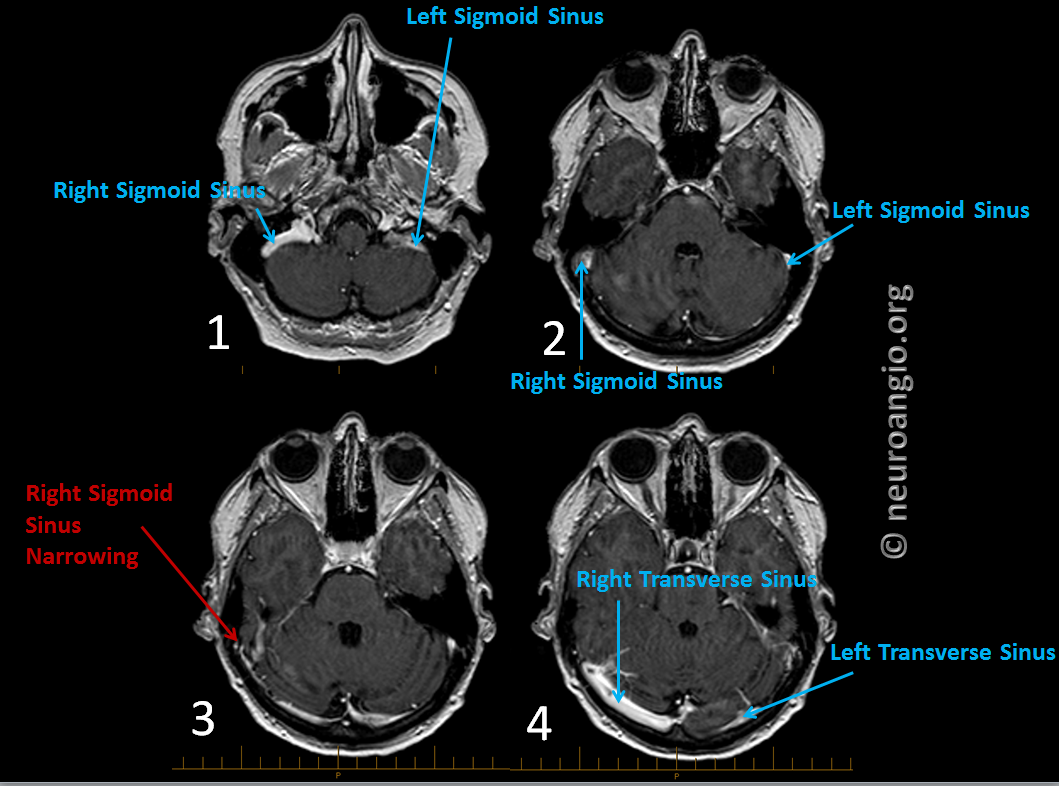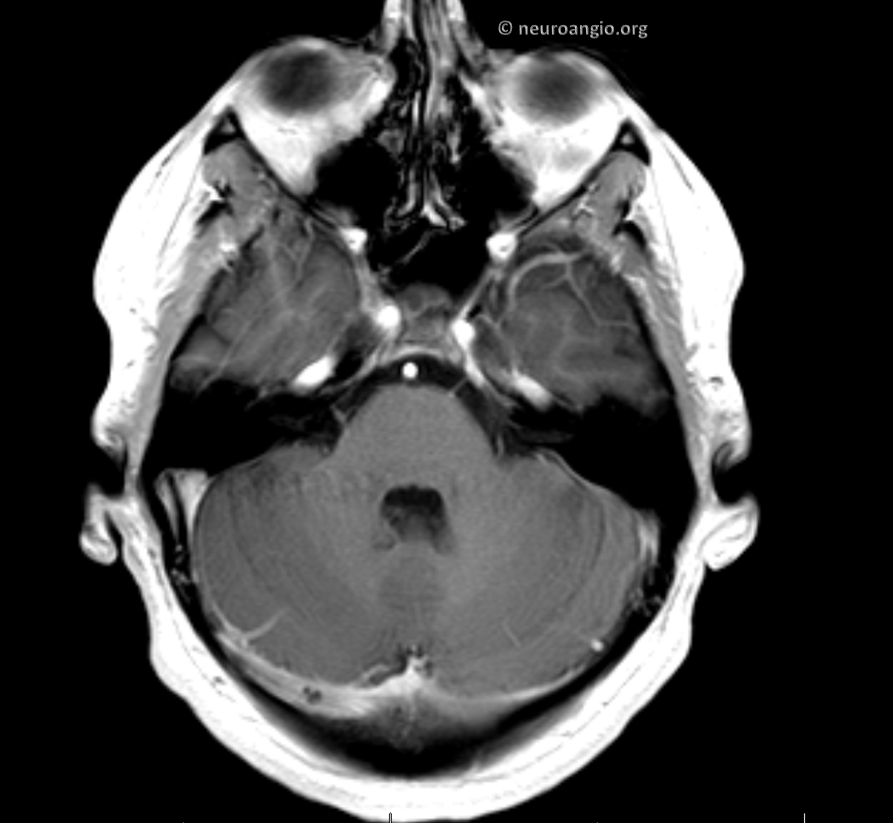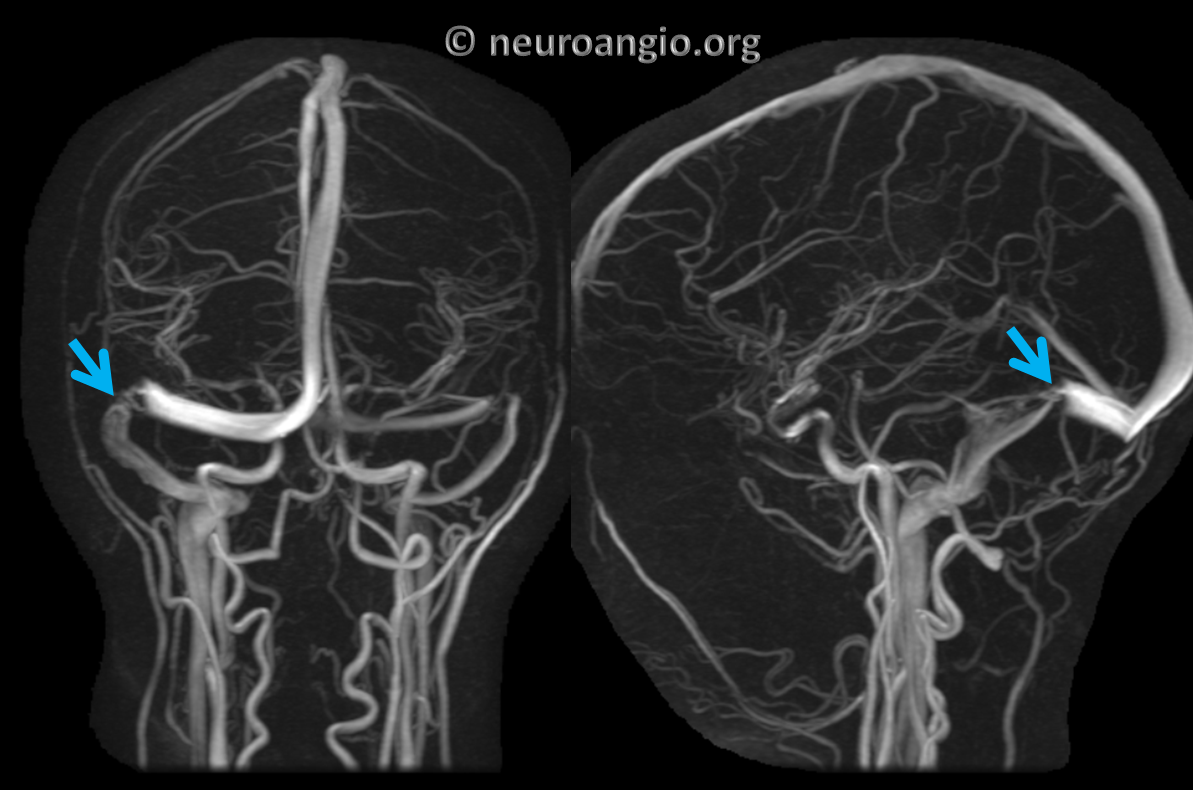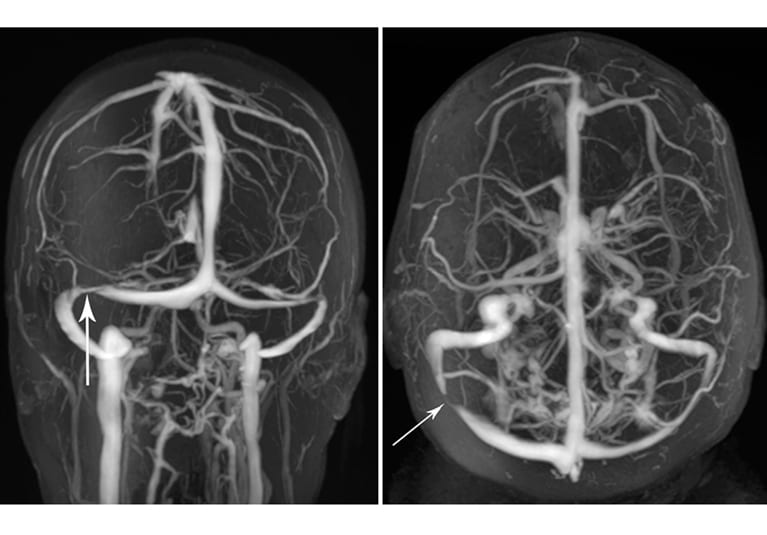Transverse sinus stenosis
Home » » Transverse sinus stenosisYour Transverse sinus stenosis images are available. Transverse sinus stenosis are a topic that is being searched for and liked by netizens now. You can Get the Transverse sinus stenosis files here. Find and Download all free photos.
If you’re looking for transverse sinus stenosis images information connected with to the transverse sinus stenosis keyword, you have come to the ideal site. Our website frequently gives you hints for viewing the maximum quality video and picture content, please kindly search and locate more enlightening video content and images that match your interests.
Transverse Sinus Stenosis. But if there is significant narrowing blood flow becomes irregular and turbulent. The transverse and sigmoid venous sinuses are located in proximity to the ear from the brain side. In turn the sigmoid sinuses continue as the jugular bulbs in the skull base. When the procedure is over you have to lay flat still for at least 4 hours.
 Figure 2 From The Relationship Of Transverse Sinus Stenosis To Bony Groove Dimensions Provides An Insight Into The Aetiology Of Idiopathic Intracranial Hypertension Semantic Scholar From semanticscholar.org
Figure 2 From The Relationship Of Transverse Sinus Stenosis To Bony Groove Dimensions Provides An Insight Into The Aetiology Of Idiopathic Intracranial Hypertension Semantic Scholar From semanticscholar.org
Transverse sinus stenoses can be seen in 2 morphologic forms. Transverse sinus stenosis is an imaging finding very highly associated with elevated intracranial pressure ICP. Purpose Transverse sinus stenosis is commonly seen in patients with idiopathic intracranial hypertension. The transverse sinuses drain the superior sagittal occipital and straight sinus and empties into the sigmoid sinus. Stenting for idiopathic intracranial hypertension has been carried out in several prior series. The procedure took about 4 hours.
The procedure is done through a tiny incision in the upper leg.
When this narrowing occurs in the transverse sinuses intracranial pressures increase and for those with connective tissue disorders the likelihood of an aneurysm significantly. The venous sinus stenting procedure involves inserting a stent in the brain to widen the narrowed veins. Transverse sinus stenoses can be seen in 2 morphologic forms. The procedure took about 4 hours. Venous Sinus Stenosis can lead to pulsatile tinnitus. Transverse Sinus Stenosis.
 Source: neurologyindia.com
Source: neurologyindia.com
Transverse sinus stenosis is an imaging finding very highly associated with elevated intracranial pressure ICP. This study evalu-ated whether patients with Chiari I malformation have transverse sinus stenosis and. Patients with the Chiari I malformation may potentially have elevated ICP due to impairment of CSF flow at the foramen magnum. Recently some studies have reported an association between idiopathic intracranial hypertension IIH and. In turn the sigmoid sinuses continue as the jugular bulbs in the skull base.
 Source: researchgate.net
Source: researchgate.net
All these patients either had 1 hypoplastic transverse sinus and a stenosis of the other sinus or bilateral TSS. An extrinsic smooth gradually narrowing tapered stenosis 7 and intrinsic discrete obstructions presumably due to arachnoid granulations or fibrous septae. The transverse sinuses drain the superior sagittal occipital and. The mean superior sagittal sinus pressure before stenting was 34 mm Hg with a mean TSS. The procedure took about 4 hours.

Stenting for idiopathic intracranial hypertension has been carried out in several prior series. Patients with the Chiari I malformation may potentially have elevated ICP due to impairment of CSF flow at the foramen magnum. Transverse sinus stenosis was identified bilaterally on MRV in 94 of patients with idiopathic intracranial hypertension and in 3 of controls. The transverse and sigmoid venous sinuses are located in proximity to the ear from the brain side. In our experience the presence of 1 functioning transverse sinus precludes the development of venous hypertension due to stenosis of the other.
 Source: ajnr.org
Source: ajnr.org
The transverse sinuses are a pair of dural venous sinuses that allow blood to drain from back the head. 10 11 While intrinsic transverse sinus stenosis might cause IIH by completely occluding the transverse sinus the extrinsic compression which resolves with CSF. An extrinsic smooth gradually narrowing tapered stenosis 7 and intrinsic discrete obstructions presumably due to arachnoid granulations or fibrous septae. The MS patients transverse sinuses had an average effective stenosis of 38 by area p65 by area and 1650 a low grade stenosis of between 40-65 by area compared to 150 low grade stenoses in this segment in. When the procedure is over you have to lay flat still for at least 4 hours.
 Source: researchgate.net
Source: researchgate.net
Transverse sinus stenoses can be seen in 2 morphologic forms. Transverse sinus stenoses can be seen in 2 morphologic forms. This study evalu-ated whether patients with Chiari I malformation have transverse sinus stenosis and. Venous Sinus Stenosis can lead to pulsatile tinnitus. Patients with the Chiari I malformation may potentially have elevated ICP due to impairment of CSF flow at the foramen magnum.
 Source: semanticscholar.org
Source: semanticscholar.org
The MS patients transverse sinuses had an average effective stenosis of 38 by area p65 by area and 1650 a low grade stenosis of between 40-65 by area compared to 150 low grade stenoses in this segment in. The percentage of transverse sinus stenosis is calculated by dividing the cross-sectional area of stenosis b by the normative area of adjacent transverse c. The entire course of transverse sinus is shown in a curved reformatting CT image a. They terminate in the sigmoid sinus just as it receives the superior petrosal sinus from the cavernous sinus. The transverse and sigmoid venous sinuses are located in proximity to the ear from the brain side.
 Source: researchgate.net
Source: researchgate.net
An extrinsic smooth gradually narrowing tapered stenosis 7 and intrinsic discrete obstructions presumably due to arachnoid granulations or fibrous septae. An extrinsic smooth gradually narrowing tapered stenosis 7 and intrinsic discrete obstructions presumably due to arachnoid granulations or fibrous septae. All these patients either had 1 hypoplastic transverse sinus and a stenosis of the other sinus or bilateral TSS. From there the drainage goes to the jugular bulb. Transverse sinus stenosis was identified bilaterally on MRV in 94 of patients with idiopathic intracranial hypertension and in 3 of controls.
 Source: neuroangio.org
Source: neuroangio.org
Patients with the Chiari I malformation may potentially have elevated ICP due to impairment of CSF flow at the foramen magnum. The venous sinus stenting procedure involves inserting a stent in the brain to widen the narrowed veins. All these patients either had 1 hypoplastic transverse sinus and a stenosis of the other sinus or bilateral TSS. Patients with the Chiari I malformation may potentially have elevated ICP due to impairment of CSF flow at the foramen magnum. Venous Sinus Stenosis can lead to pulsatile tinnitus.
 Source: neuroangio.org
Source: neuroangio.org
When this narrowing occurs in the transverse sinuses intracranial pressures increase and for those with connective tissue disorders the likelihood of an aneurysm significantly. Abnormal narrowing of transverse sinuses. On coronal T1 postgadolinium MR images transverse sinus stenosis was identified in 83 of patients with idiopathic intracranial hypertension and 7 of controls. 10 11 While intrinsic transverse sinus stenosis might cause IIH by completely occluding the transverse sinus the extrinsic compression which resolves with CSF. Transverse sinus stenosis is an imaging finding very highly associated with elevated intracranial pressure ICP.
 Source: researchgate.net
Source: researchgate.net
Recently some studies have reported an association between idiopathic intracranial hypertension IIH and. Venous Sinus Stenosis can lead to pulsatile tinnitus. The mean superior sagittal sinus pressure before stenting was 34 mm Hg with a mean TSS. The MS patients transverse sinuses had an average effective stenosis of 38 by area p65 by area and 1650 a low grade stenosis of between 40-65 by area compared to 150 low grade stenoses in this segment in. When this narrowing occurs in the transverse sinuses intracranial pressures increase and for those with connective tissue disorders the likelihood of an aneurysm significantly.
 Source: researchgate.net
Source: researchgate.net
There is some evidence that the venous abnormalities are secondary to the intracranial hypertension. Abnormal narrowing of transverse sinuses. Stenting for idiopathic intracranial hypertension has been carried out in several prior series. Under normal circumstances blood flow is smooth. The entire course of transverse sinus is shown in a curved reformatting CT image a.
 Source: ejradiology.com
Source: ejradiology.com
Bilateral transverse sinus stenosis in patients with tinnitus Tinnitus is a frequent complaint in patients affected by intracranial hypertension IH. Transverse sinus stenosis was identified bilaterally on MRV in 94 of patients with idiopathic intracranial hypertension and in 3 of controls. When the procedure is over you have to lay flat still for at least 4 hours. The transverse sinuses are a pair of dural venous sinuses that allow blood to drain from back the head. The transverse blue and sigmoid white sinuses are normal.
 Source: neuroangio.org
Source: neuroangio.org
There is a severe proximal sigmoid sinus stenosis present red. But if there is significant narrowing blood flow becomes irregular and turbulent. Patients with the Chiari I malformation may potentially have elevated ICP due to impairment of CSF flow at the foramen magnum. This study evalu-ated whether patients with Chiari I malformation have transverse sinus stenosis and. The procedure is done through a tiny incision in the upper leg.
 Source: mayoclinic.org
Source: mayoclinic.org
The mean superior sagittal sinus pressure before stenting was 34 mm Hg with a mean TSS. Transverse Sinus Stenosis. The transverse sinuses drain the superior sagittal occipital and straight sinus and empties into the sigmoid sinus. In turn the sigmoid sinuses continue as the jugular bulbs in the skull base. The venous sinus stenting procedure involves inserting a stent in the brain to widen the narrowed veins.
 Source: researchgate.net
Source: researchgate.net
Patients with the Chiari I malformation may potentially have elevated ICP due to impairment of CSF flow at the foramen magnum. The MS patients transverse sinuses had an average effective stenosis of 38 by area p65 by area and 1650 a low grade stenosis of between 40-65 by area compared to 150 low grade stenoses in this segment in. Transverse Sinus Stenosis. The transverse and sigmoid venous sinuses are located in proximity to the ear from the brain side. Abnormal narrowing of transverse sinuses.
 Source: semanticscholar.org
Source: semanticscholar.org
Transverse sinus stenosis was identified bilaterally on MRV in 94 of patients with idiopathic intracranial hypertension and in 3 of controls. The mean superior sagittal sinus pressure before stenting was 34 mm Hg with a mean TSS. In our experience the presence of 1 functioning transverse sinus precludes the development of venous hypertension due to stenosis of the other. The transverse sinuses drain the superior sagittal occipital and straight sinus and empties into the sigmoid sinus. It is not clear whether it is the cause or the result of idiopathic intracranial hypertension.
 Source: medpix.nlm.nih.gov
Source: medpix.nlm.nih.gov
Transverse sinus stenosis is an imaging finding very highly associated with elevated intracranial pressure ICP. The transverse sinuses drain the superior sagittal occipital and straight sinus and empties into the sigmoid sinus. Stenting for idiopathic intracranial hypertension has been carried out in several prior series. The venous sinus stenting procedure involves inserting a stent in the brain to widen the narrowed veins. This study evalu-ated whether patients with Chiari I malformation have transverse sinus stenosis and.
 Source: jbsr.be
Source: jbsr.be
They terminate in the sigmoid sinus just as it receives the superior petrosal sinus from the cavernous sinus. Abnormal narrowing of transverse sinuses. An extrinsic smooth gradually narrowing tapered stenosis 7 and intrinsic discrete obstructions presumably due to arachnoid granulations or fibrous septae. The procedure is done through a tiny incision in the upper leg. Recently some studies have reported an association between idiopathic intracranial hypertension IIH and.
This site is an open community for users to submit their favorite wallpapers on the internet, all images or pictures in this website are for personal wallpaper use only, it is stricly prohibited to use this wallpaper for commercial purposes, if you are the author and find this image is shared without your permission, please kindly raise a DMCA report to Us.
If you find this site value, please support us by sharing this posts to your favorite social media accounts like Facebook, Instagram and so on or you can also save this blog page with the title transverse sinus stenosis by using Ctrl + D for devices a laptop with a Windows operating system or Command + D for laptops with an Apple operating system. If you use a smartphone, you can also use the drawer menu of the browser you are using. Whether it’s a Windows, Mac, iOS or Android operating system, you will still be able to bookmark this website.